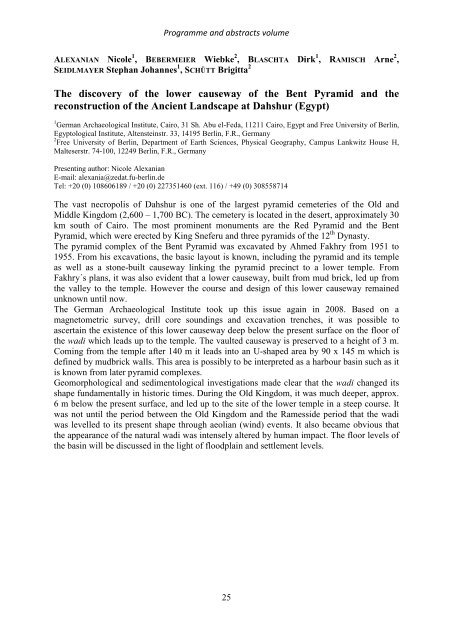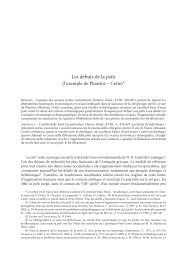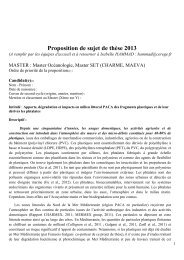LANDSCAPE ARCHAEOlOGY. EGYPT AND THE ... - CFEETK - CNRS
LANDSCAPE ARCHAEOlOGY. EGYPT AND THE ... - CFEETK - CNRS
LANDSCAPE ARCHAEOlOGY. EGYPT AND THE ... - CFEETK - CNRS
Create successful ePaper yourself
Turn your PDF publications into a flip-book with our unique Google optimized e-Paper software.
Programme and abstracts volume<br />
ALEXANIAN Nicole 1 , BEBERMEIER Wiebke 2 , BLASCHTA Dirk 1 , RAMISCH Arne 2 ,<br />
SEIDLMAYER Stephan Johannes 1 , SCHÜTT Brigitta 2<br />
The discovery of the lower causeway of the Bent Pyramid and the<br />
reconstruction of the Ancient Landscape at Dahshur (Egypt)<br />
1 German Archaeological Institute, Cairo, 31 Sh. Abu el-Feda, 11211 Cairo, Egypt and Free University of Berlin,<br />
Egyptological Institute, Altensteinstr. 33, 14195 Berlin, F.R., Germany<br />
2 Free University of Berlin, Department of Earth Sciences, Physical Geography, Campus Lankwitz House H,<br />
Malteserstr. 74-100, 12249 Berlin, F.R., Germany<br />
Presenting author: Nicole Alexanian<br />
E-mail: alexania@zedat.fu-berlin.de<br />
Tel: +20 (0) 108606189 / +20 (0) 227351460 (ext. 116) / +49 (0) 308558714<br />
The vast necropolis of Dahshur is one of the largest pyramid cemeteries of the Old and<br />
Middle Kingdom (2,600 – 1,700 BC). The cemetery is located in the desert, approximately 30<br />
km south of Cairo. The most prominent monuments are the Red Pyramid and the Bent<br />
Pyramid, which were erected by King Sneferu and three pyramids of the 12 th Dynasty.<br />
The pyramid complex of the Bent Pyramid was excavated by Ahmed Fakhry from 1951 to<br />
1955. From his excavations, the basic layout is known, including the pyramid and its temple<br />
as well as a stone-built causeway linking the pyramid precinct to a lower temple. From<br />
Fakhry´s plans, it was also evident that a lower causeway, built from mud brick, led up from<br />
the valley to the temple. However the course and design of this lower causeway remained<br />
unknown until now.<br />
The German Archaeological Institute took up this issue again in 2008. Based on a<br />
magnetometric survey, drill core soundings and excavation trenches, it was possible to<br />
ascertain the existence of this lower causeway deep below the present surface on the floor of<br />
the wadi which leads up to the temple. The vaulted causeway is preserved to a height of 3 m.<br />
Coming from the temple after 140 m it leads into an U-shaped area by 90 x 145 m which is<br />
defined by mudbrick walls. This area is possibly to be interpreted as a harbour basin such as it<br />
is known from later pyramid complexes.<br />
Geomorphological and sedimentological investigations made clear that the wadi changed its<br />
shape fundamentally in historic times. During the Old Kingdom, it was much deeper, approx.<br />
6 m below the present surface, and led up to the site of the lower temple in a steep course. It<br />
was not until the period between the Old Kingdom and the Ramesside period that the wadi<br />
was levelled to its present shape through aeolian (wind) events. It also became obvious that<br />
the appearance of the natural wadi was intensely altered by human impact. The floor levels of<br />
the basin will be discussed in the light of floodplain and settlement levels.<br />
25








